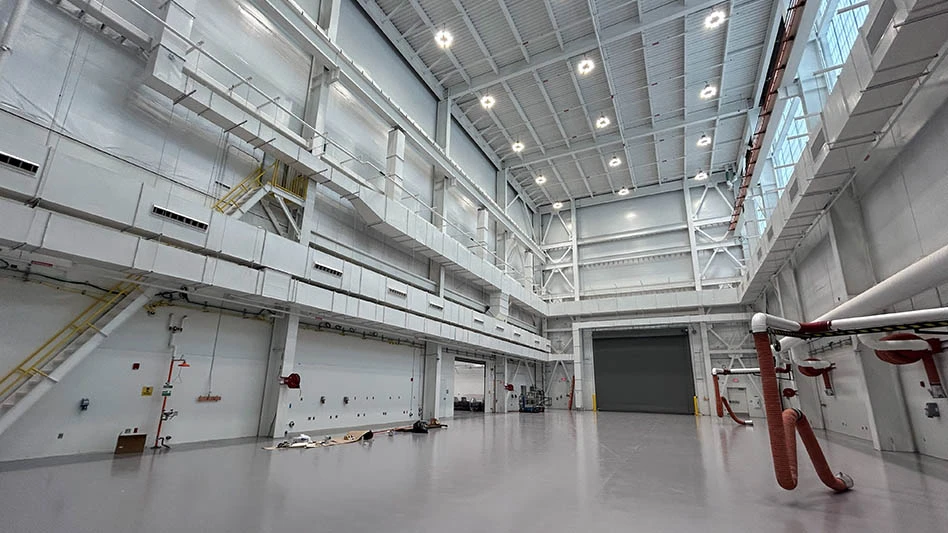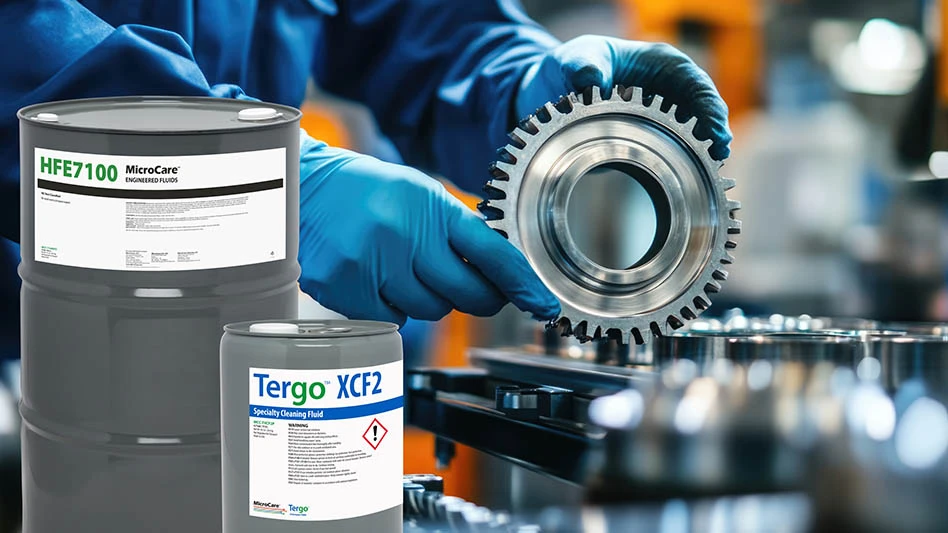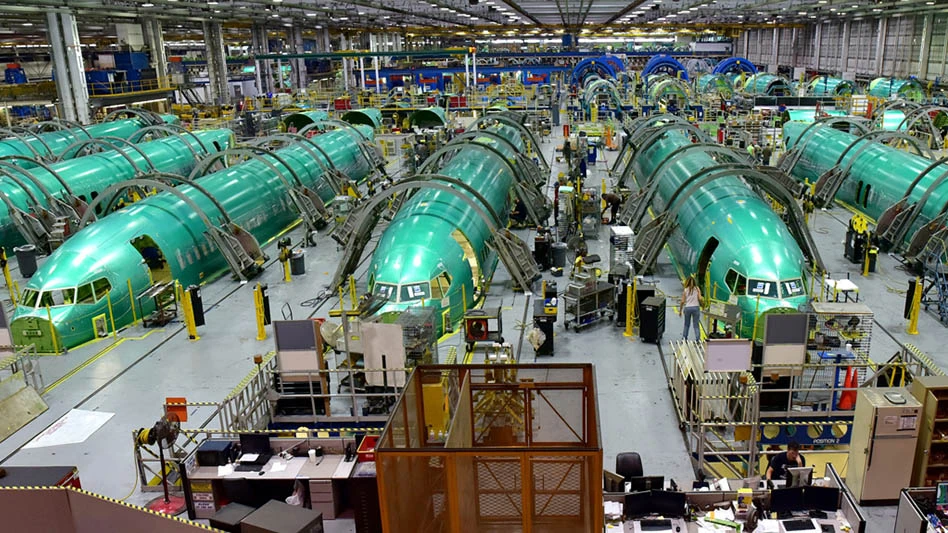

The rapid evolution of artificial intelligence (AI) is impacting a variety of industries and even caused tech mogul Elon Musk to sound the alarm and warn that if not properly reined in, AI advancement could ultimately lead to “civilizational destruction.” Despite the warnings, AI (in one form or another) is here to stay. As such, its effects on industries such as aerospace manufacturing will grow more pronounced in the coming years.
Mordor Intelligence, in an analysis of AI and robotics in aerospace and defense (A&D), reports the AI market is expected to grow by a compound annual growth rate (CAGR) of 7.5% from 2023 to 2028, increasing from $29.67 billion this year to $42.60 billion by the end of the period. As its usage grows, AI has had myriad impacts on the industry ranging from good to bad to downright awful. For instance, AI has increased manufacturing efficiency, which is good. But it’s also raised ethical dilemmas, which is bad, and produced security risks with the potential to produce some truly awful situations for companies. These wide-ranging effects highlight the need for aerospace firms to strike the right balance in AI adoption to maximize benefits and minimize risks.
The good
AI has quickly revolutionized certain aspects of the manufacturing process and ushered in a new era of efficiency and productivity. By analyzing vast amounts of sensor data from aircraft systems and components, AI algorithms can detect anomalies, predict failures, and trigger maintenance actions before issues occur. This predictive maintenance helps optimize performance and reduce downtime. When Swiss International Airlines began using AI to boost efficiency, it reported it could optimize more than half the flights in its network and save five million Swiss francs in 2022.
GE Aerospace is a leader in this area, with its digital twins AI technology enabling the company to monitor and analyze real-time data from aircraft engines. This tool helps predict component degradation, allowing airlines to plan maintenance proactively and avoid unexpected disruptions.
Quality control is another area where AI technology has a significant positive impact. By leveraging computer vision and machine learning (ML) algorithms, AI systems can quickly inspect and identify defects in components or assemblies with greater accuracy and speed than humans. This reduces the likelihood of faulty parts entering the supply chain and enhances overall product quality.
Airbus uses AI-based computer vision systems to inspect aircraft components, detect flaws, and ensure adherence to stringent quality standards. According to the company, this reduced inspection time and increased defect detection rates, improving overall manufacturing efficiency.
AI technology is also enhancing aerospace manufacturing through intelligent robotics and automation systems. Robots equipped with AI algorithms can perform complex assembly operations with precision, speed, and consistency, reducing human error and increasing output. Boeing uses AI-powered robotic systems for drilling, painting, and assembly operations, and reports experiencing enhanced production efficiency and reduced cycle times. According to a study by Valoir, an independent analyst firm, 40% of the aerospace workday can be automated with AI. Already, 20% was automated in just the past two years.
AI also positively impacts the aerospace market through supply chain optimization. AI has transformed inventory management, demand forecasting, and logistics operations. A recent McKinsey report found AI can improve supply forecasting accuracy by 10% to 20%. That improvement then translates to a 5% reduction in inventory costs and a 2% to 3% increase in revenue.
The bad

Of course, all the news surrounding the use of AI in aerospace isn’t positive. Companies are also reporting negative impacts from their use of AI. For instance, because AI algorithms depend heavily on high-quality and relevant data for accurate decision-making when companies have inadequate or biased data, which happens often, they get flawed predictions and incorrect decisions. Analysts at the Center for Security and Emerging Technology at Georgetown University recently presented a fictitious but worrisome example of this. In that incident, AI mistook atmospheric conditions over the Bering Strait for a missile attack and launched missile interceptors, which China then viewed as an attack against them.
Another common issue with AI is it can be difficult to explain the reasoning behind a decision. In safety-critical aerospace applications, explainability and interpretability are often crucial to gain regulator and user trust. An additional negative associated with AI is workforce disruption. While AI can improve efficiency, it may also lead to job displacement and workforce disruption by requiring retraining and upskilling employees. The World Economic Forum (WEF) reported nearly a quarter of all jobs, including in the aerospace market, will change due to AI. The WEF survey shows 75% of companies expect to adopt AI technologies during the next five years, and up to 26 million record-keeping and administrative-type jobs will be eliminated.
The awful
With the appearance of new technology such as AI, which can transform a market, there are always ethical and security concerns. Failure to address these issues could lead to truly awful situations where unauthorized access is gained, manufacturing is compromised, or sensitive data is released.
The sheer complexity of most AI systems makes them an increased safety risk because errors, malfunctions, or adversarial attacks on AI algorithms could have awful implications for aerospace operations. Ensuring AI’s reliability, robustness, and fail-safe mechanisms in safety-critical applications is of utmost importance, and many companies recognize this. Airbus established Airbus Cybersecurity. Boeing implemented a Secure Development Lifecycle (SDL) for its software development processes. NASA currently operates a Security Operations Center that provides 24/7 monitoring and incident response for its critical systems. The Defense Advanced Research Projects Agency (DARPA) initiated the CASE program to develop new tools, methodologies, and techniques for designing and building secure AI systems. Time will tell whether these initiatives are enough to prevent awful developments from occurring.
AI strategies
How can companies safely integrate AI into their operations so they experience the benefits of the technology while avoiding the potential bad and awful side effects? First, companies need to develop regulations and ethical frameworks to guide the responsible use of AI. Additional strategies companies can implement include defining clear goals and use cases, establishing a robust data management strategy, and investing in talent and skills development. They also can foster collaboration between domain experts and data scientists to effectively apply AI, ensure seamless integration with existing systems, and continuously monitor and evaluate performance.
Companies can also start with smaller, pilot AI projects instead of immediately attempting large-scale implementations. These pilot projects help businesses learn from initial implementations, identify challenges, validate AI’s feasibility and potential benefits, and make necessary adjustments.
The future
Despite the potential bad and awful effects of AI, it’s become clear that for AI, the good outweighs the bad and AI is here to stay. It’s already proven to be highly effective at streamlining the aircraft design process. AI technology also enhances the manufacturing process by automating quality control, detecting defects in components, and optimizing production lines for increased efficiency.
The benefits of AI don’t stop there. It can improve aircraft maintenance operations and optimize air traffic management. AI also is key to the ongoing growth of autonomous flight and unmanned systems and the expansion of space exploration and satellite systems. In 2020, Boeing successfully completed a series of test flights showing uncrewed aircraft can operate together, controlled by AI-driven data sharing and onboard command.
A balanced approach
When revolutionary technology appears on the scene, it can provoke extreme reactions within an industry. Companies either go overboard in using the tool or refuse to use it altogether. The better approach to AI is a balanced one. It’s essential companies assess how AI can deliver benefits such as enhanced aircraft performance, optimized flight routes, improved safety measures, and streamlined maintenance processes. This must be weighed against the need for expert knowledge and understanding of topics including data quality, regulatory concerns, ethical considerations, and potential biases in AI algorithms.
Companies that strike this careful balance can achieve responsible AI deployment that maximizes benefits, minimizes risks, and appropriately addresses job displacement and human oversight of AI. This balanced approach can foster a collaborative environment where humans and AI work together to create exciting advancements in aviation and space technology.

Explore the September 2023 Issue
Check out more from this issue and find your next story to read.
Latest from Aerospace Manufacturing and Design
- OMA and NIMS partner to launch semiconductor technician credentials
- Analysis, trends, and forecasts for the future of additive manufacturing
- BlueForge Alliance Webinar Series Part III: Integrate Nationally, Catalyze Locally
- Blaser Swisslube, NIDEC Machine Tool America partner
- Extrusion crosshead combines concentricity adjustment, fastener-free assembly
- Vertical Aerospace unveils Valo eVTOL aircraft
- 3xD pilot step drill
- #56 Lunch + Learn Podcast with Techman Robot + AMET Inc.





